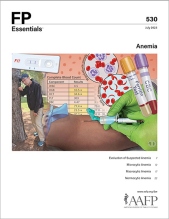
This clinical content conforms to AAFP criteria for CME.
Normocytic anemia is anemia with a mean corpuscular volume of 80 to100 mcm3. Its causes include anemia of inflammation, hemolytic anemia, anemia of chronic kidney disease, acute blood loss anemia, and aplastic anemia. In most cases, correction of the anemia should focus on managing the underlying condition. Red blood cell transfusions should be limited to patients with severe symptomatic anemia. Hemolytic anemia can be diagnosed based on signs and symptoms of hemolysis, such as jaundice, hepatosplenomegaly, unconjugated hyperbilirubinemia, increased reticulocyte count, and decreased haptoglobin levels. Use of erythropoiesis-stimulating agents in patients with anemia due to chronic kidney disease should be individualized, but these agents should not be initiated in asymptomatic patients until the hemoglobin level is less than 10 g/dL. Cessation of bleeding is the focus of acute blood loss anemia, and management of the initial hypovolemia typically should be with crystalloid fluids. A mass transfusion protocol should be initiated if the blood loss is severe and ongoing with hemodynamic instability. Aplastic anemia management focuses on improving blood cell counts and limiting transfusions.
Case 4. MG is a 50-year-old patient with uncontrolled rheumatoid arthritis. Her rheumatologist recently prescribed a new treatment. Laboratory test results from that visit showed a low hemoglobin level of 10.5 g/dL and a normal mean corpuscular volume of 87 mcm3. MG feels fatigued and asks if taking an iron supplement would help improve her energy.
Subscribe
From $350- Immediate, unlimited access to FP Essentials content
- 60 CME credits/year
- AAFP app access
- Print delivery available
Edition Access
$44- Immediate, unlimited access to this edition's content
- 5 CME credits
- AAFP app access
- Print delivery available
